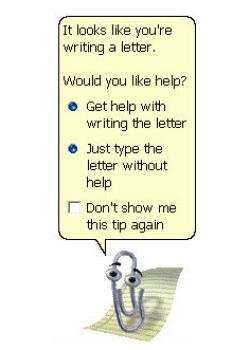Tom Socca writes the epitaph for Redmond’s increasingly annoying ultimate piece of bloatware.
Nowadays, I get [a] feeling of dread when I open an email to see a Microsoft Word document attached. Time and effort are about to be wasted cleaning up someone’s archaic habits. A Word file is the story-fax of the early 21st century: cumbersome, inefficient, and a relic of obsolete assumptions about technology. It’s time to give up on Word. …
[Word] become an overbearing boss, one who specializes in make-work. Part of this is Microsoft’s more-is-more approach to adding capabilities, and leaving all of them in the “on” position. Around the first time Clippy launched himself, uninvited, between me and something I was trying to write, I found myself wishing Word had a simple, built-in button for “cut it out and never again do that thing you just did.” It’s possible that the current version of Word does have one; I have no idea where among the layers of menus and toolbars it might be. All I really know how to do up there anymore is to go in and disable AutoCorrect, so that the program will type what I’ve typed, rather than what some software engineer thinks it should think I’m trying to type.
Word’s stylistic preferences range from the irritating—the superscript “th” on ordinal numbers, the eagerness to forcibly indent any numbered list it detects—to the outright wrong. Microsoft’s inability to teach a computer to use an apostrophe correctly, through its comically misnamed “smart quotes” feature, has spread from the virtual world into the real one, till professional ballplayers take the field with amateur punctuation on their hats.
Even so, people can live with typos in their input. (Witness the boom in paraphasic email Sent From My iPhone.) What makes Word unbearable is the output. Like the fax machine, Word was designed to put things on paper. It was a tool of the desktop-publishing revolution, allowing ordinary computer users to make professional (or at least approximately professional) document layouts and to print them out. That’s great if you’re making a lot of church bulletins or lost-dog fliers. Keep on using Word. (Maybe keep better track of your dog, though.)
For most people now, though, publishing means putting things on the Web. Desktop publishing has given way to laptop or smartphone publishing. And Microsoft Word is an atrocious tool for Web writing. Its document-formatting mission means that every piece of text it creates is thickly wrapped in metadata, layer on layer of invisible, unnecessary instructions about how the words should look on paper.






Please Leave a Comment!